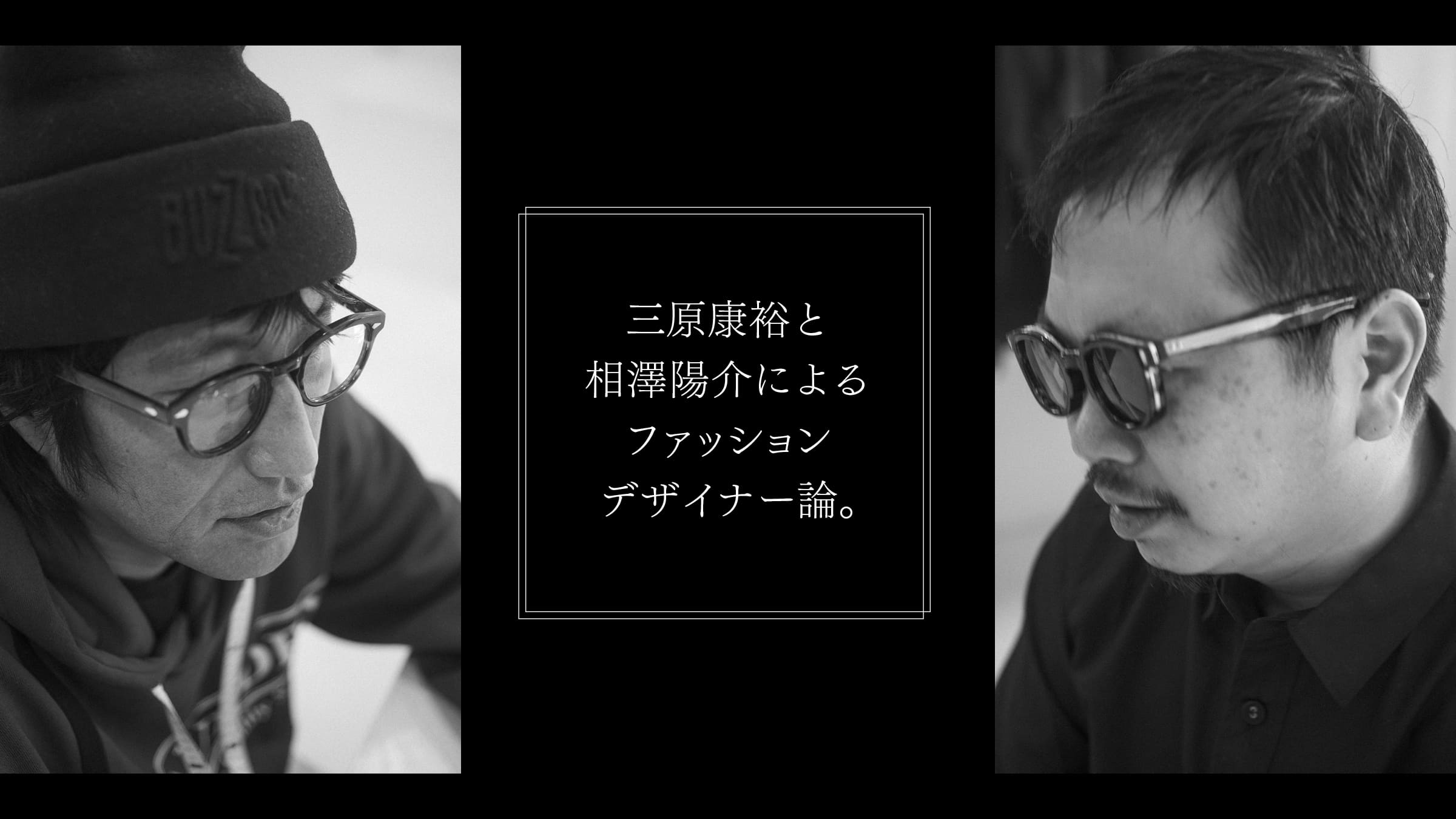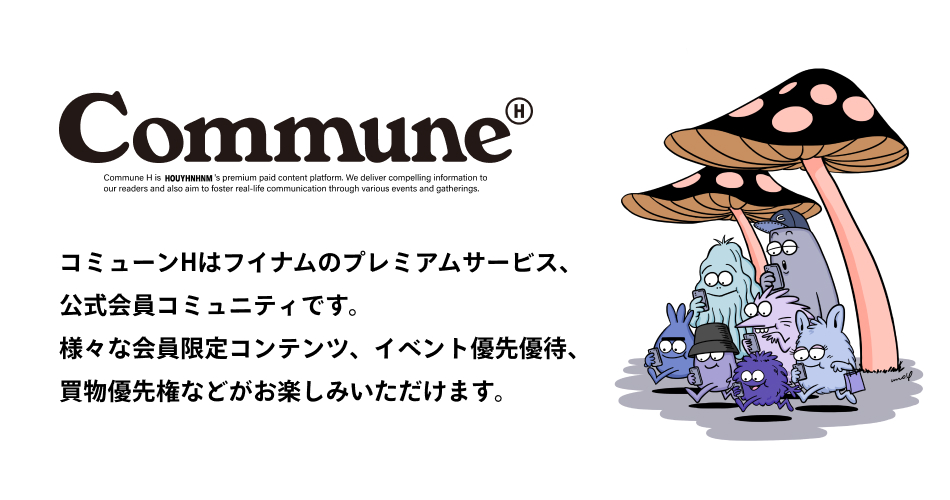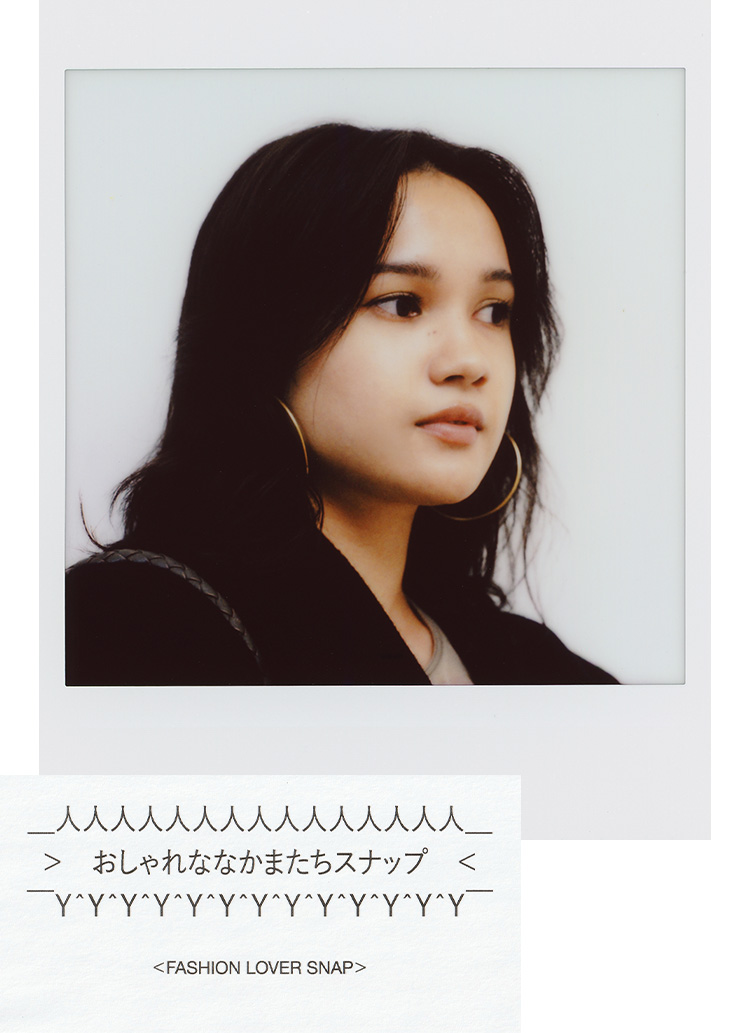What do you think of Mr. Aizawa?
Mihara:Aizawa-kun has a specific thing to do. . he is not expressing himself by destroying Western culture.
What do you mean?
Mihara:I think that my predecessors expressed their Oriental identity by destroying European culture. From haute couture to prêt-à-porter, then to the mode era, and then to the anti-mode era, what designers of the next era should be? Then, what was the next generation of designers?
I see.
Mihara:Not fashion that comes from design , but expression that begins with clothing. . including functionality. In that respect, I think it was unique from the beginning. . So when I first saw it, I felt a little uncomfortable. There have been brands that have come from non-modal sources, but this was a little different. . There is an emphasis on the product aspect, but there is also the designer's ego. I was interested to see how the balance between the two would develop in the future.
Conversely, how do you see Mr. Mihara from your point of view?
Aizawa:Mr. Mihara is very knowledgeable. . about fashion, art, and art in general. . However, when he gets drunk, he doesn't know what he is talking about.
(laughs).
Aizawa:And, although I have seen such contexts in my own way, Mr. Mihara discusses such things very correctly. He is like a professor. However, Mr. Mihara completely separates his creative side from his knowledge of fashion and art. I think that he transmits information based on what he is doing now. I think that is similar to me. I was also an art student and have learned many things, but I don't want to say a single word about art in my design and creation work.
Mihara:Yes, it is.

Aizawa:But there are brands that do not. I feel that the word "artistic" or "creation" is used as a defensive term for making something.
Mihara:You misunderstand the word creation.
Aizawa:I think it is actually the easiest thing for me to say something artistic that someone else would have said before I say it myself. . I feel very uncomfortable with the situation where the thing comes later and the thing comes first. I agree with Mihara-san and myself that "a thing is just a thing," and I can sympathize with him in the sense that he ignores all contexts.
Mihara:That's what I can relate to most when I see what you make, Aizawa. A thing is a thing. That is very important. We were in the design course, but I think we really have to study from the point of view of what design is. I think we really need to learn from the question, "What is design? If you look up the meaning of "design" in a dictionary, it means "design," and nowadays it also means a methodology for solving problems. But what is art for us? What is design? . I think you have to decide the scale by yourself.
You mentioned this in your interview with Mr. Ino of "Doublet.
Mihara:. yes. As I said then, I think it is no good to have a cake that looks good but doesn't taste good when you eat it. In the past, there were many bad cakes, but now there are many delicious cakes. The reason for this is that they have done a lot of research on ingredients such as sponge and cream. Nowadays, many cakes are interesting to look at, but as a product, I think they are completely useless. . That's why I tend to be negative about a lot of things. . Or rather, I don't think they should be destroyed in the first place.
What do you mean?
Mihara:In other words, if you want to do something avant-garde or innovative, you should first study the basics thoroughly. As Kanzaburo Nakamura said, breaking the mold is only possible when there is a mold to break. I think that everyone learns how to break the mold first, and that there is a lack of accumulation, effort, and labor in the process of creation.
I see.
Mihara:If you have something to do and then do something as an expression, that's fine, but if you start chasing after that all the time, I don't think you can do it even if you are asked to make something proper. ~. I think it is possible to do something like that, since there is so much information available nowadays.
Aizawa:We've talked about this kind of thing before.

Mihara:I did. I did it through a messenger or something. Anyway, it is said that we have moved from the age of manufacturing to the age of value-added, but I don't approve of the neglect of the product itself. There are people who become famous only because of who wears their clothes or something like that. Well, I can't help but speak harshly about them.
Aizawa:That's fine with you, Mr. Mihara. Well, in my opinion, there are people who want to prolong their creative spans. They want to confirm their own potential by keeping a single event for a long period of time. But what I and Mr. Mihara are doing is completely different from that.
What exactly do you mean?
Aizawa:For example, Mr. Mihara has collaborated with Puma and I with Adidas in the past. In addition, Mr. Mihara is the creative director of Crestbridge and I am the creative director of Hunting World. In these jobs, it is not possible to stay with one project for a long period of time.
In other words, the span of time to think about things is short.
Aizawa:. yes. We don't have much time, but we have to apply fashion design to that span. That's why I think Virgil Abloh and Jonathan Anderson are simply amazing. I don't mean that in the subjective sense of liking them as designers. They are working in a big field like " Louis Vuitton " or " Loewe " that no one can talk about, and they are designing fashion in an environment where they may lose their contracts next year. So I think they are conscious of packing a lot of information into a six-month collection. In my opinion, this is the proper way for a fashion designer to work.
A person must be able to see the big picture and have a bird's eye view of things.
Aizawa:Also, for my part, I am not good at talking about creativity easily or calling it artisanal. It is fine if we are talking about a different cycle than the language used to acknowledge the cycle of fashion, but if designers talk about it in that context, I think it is a denial of the cycle of the field in which we are currently in.
Yes, that's right.
Aizawa:In such a case, it makes no sense unless we make it from that business cycle, and it seems self-protective to say that within the existing fashion cycle and business. . In a sense, maybe the sense of being in business is important. Sometimes I am told, "You sound like a businessman. I don't think it's a bad thing.
I see you put it that way.
Aizawa:They say it's a mess.
Mihara:I've been told that too. . but when you take a job somewhere, there are sales you have to achieve. . but as long as I accept a job somewhere, there are still sales I have to achieve. The scale of sales is totally different from my own brand, and in order to get those numbers, I have to make a lot of decisions.
That's true. The clientele will be different.
Mihara:Yes. The scale of my brand is dozens of times larger than that of mine, and the absolute number and demographics of the people I sell to are different. It is not enough to simply make it fashionable, but it is necessary to meet the needs of the market. I have to plan how to attract new customers, and everything has to be done in a systematic way, and there should not be any fluctuation. You may be told at a meeting that the sales dropped 5% from last year (compared to last year) and you may think it is not that much, but the original number is so large that if you think about it in terms of sales, the drop is several hundred million yen.
Aizawa:There is, isn't there, that. Even just a few percent is a ridiculous number (laughs).

Mihara:In the case of sneakers, it is a world of "let's sell tens of thousands of pairs. For my own brand, I think even 10,000 pairs is a great number, but when I was working with Puma, it was a different order of magnitude. But now, sneakers are at war.
Aizawa:Indeed .
Mihara:It's a big war. I didn't collaborate with " Puma " until 2015. I pulled the curtain back on that myself, but even then there was a bit of a trend. When I started working with Puma in 1999, there weren't many collaborations, and things were quiet, but from there it just got more and more intense.
Yes, that's right.
Mihara:How many pairs of collaborative sneakers do you get in a week now? It's like, "How many pairs of collaborative sneakers can you get in a week? If you stay in Japan, you would not know it, but if you look around the world, there is a great war going on. It is very difficult to fight in such a sneaker war. That is why I think Aizawa is amazing.
Aizawa:Sneakers are difficult to sell if they are made only from the perspective of what you would normally wear. If you make a sneaker with the intention of wearing it yourself, you have to cut down on the design. If you do that, your sneakers will be buried under the rest. It is no longer possible to make a product just because you like it. It is difficult to make a product unless you are aware that you are making sneakers for today's market.

Mihara:Oh, by the way, there was a pair of sneakers from White Mountaineering that I really liked. The ones with the letters "bar" on the sole. They were cool.
Aizawa:Thank you very much.
Sneakers aren't the only thing that's been on the rise lately, but resale has really taken off as well.
Aizawa:Yes, I have. There are many second-hand sneaker shops in New York now, and the sneakers I made there were sold at about three times the price.
Not so much!
Aizawa:So there are piles of those things on the wall. It's very interesting to see them displayed among those premier sneakers. And even among that many sneakers on display, I can instantly recognize the ones I made. . The reason for this is that I emphasize the impact of my designs.
I guess there are things you can see when you put them side by side with other sneakers like that.
Aizawa:Yes, I think so. I think that people who can add can also subtract. Nowadays, as in school education and in the case of many brands, people talk about the beauty of subtraction. However, a person who has never added cannot subtract. It is better to think honestly about what it means to subtract, and the product will be more viable.
Mihara:Now you are saying very good things. I don't know where it got twisted, but the theory of subtraction has been said since the Bauhaus days. (It is also mentioned in the words of Jean Prouvé. There was "Art Nouveau," which added up, and then there was "Art Deco," which was simpler. In the genealogy of the change from addition to subtraction, if we translate this into the life of a single creator, there will always be an era of addition and an era of subtraction. It also has to do with how it is linked to the trends of the world. However, as Mr. Aizawa says, those who cannot do addition are not good at subtraction either. People who can only do subtraction always say, "I am making what people want. But there are many things in the world that have been subtracted, so what's wrong with that?
Indeed .
Mihara:I have seen many designers who create products that meet the needs of the market, but it is difficult to attract people by subtraction alone. If you can attract people, you can create a market. I believe that an innovator must have the ability to create a market, not just design.










